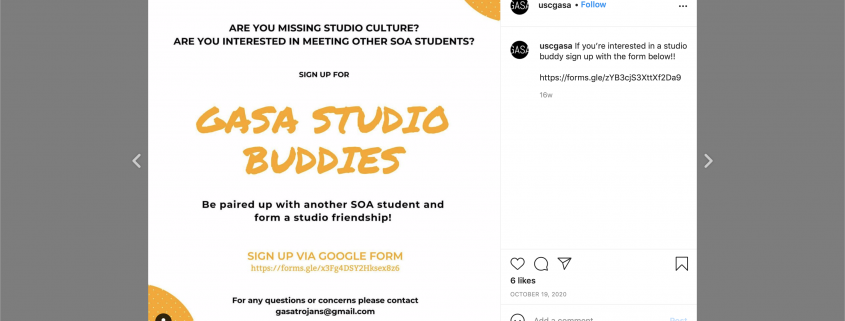Architecture students create mentorship program

Soon after entering the world of online learning, several members of the School of Architecture noticed something missing: the normally in-person studio space, where students could walk around to their peers’ desks, ask questions and converse about projects. This created a close and collaborative environment between all the graduate students.
Interested in recreating this environment, architecture master’s students JP Luikart, Louise Rogier and Shay Mirzaei created the Architecture Studio Buddies program to bring an essential part of the student experience to a virtual forum.
“We can pretty much only see our own (at home) studios and that already creates a gap between the year that we’re currently in ourselves because we can’t even see what our colleagues that are in the same year as I start doing, let alone, seeing what the year above or below us are doing” Mirzaei said.
In a time when many school communal environments are unavailable to enhance a student’s campus experience, the Buddies Program has pushed past barriers to ensure support for new and old members of the studio space program, Mirzaei said.
For some, it’s a way of receiving advice on projects and classes. For others, it can involve working on projects together or forming new connections within the program.
Mirzaei was paired with a first-year graduate student who shared her previous experience studying psychology as an undergraduate student. Mirzaei said the two made a strong connection, talking about classes, the transition between psychology and architecture, and how the program had evolved since Mirzaei’s first year.
The pairings in the mentorship program were created strategically. Students filled out detailed questionnaires about their hobbies and interests within architecture. Overall, the pairings have been successful and Mirzaei said she received a lot of positive responses from the students involved.
“There’s been other people that have reached out to me about how much they love the program or there’s been people that didn’t have the chance to participate, partially because … it’s an additional thing in your schedule and they’re probably nervous, but they’ve been reaching out and asking for another round of this (program),” Mirzaei said.
The challenge for the Buddies Program originally was finding the correct means to replace such an essential environment, Luikart said. With each student at a different point in their academic career, whether as new students or finishing their degree, the program needed to incorporate all stages of learning for students. It also required an aspect of flexibility, especially since students already spend hours online in class and are busy with an assortment of their own commitments.
“That’s why it took a while to develop this particular solution because everyone’s sort of in it for something different,” Luikart said. “(We came) up with something that’s flexible enough that if you want to talk about only work that’s fine and if you want to talk about nothing relating to work, you just want someone to relax with, that’s fine too.”
At the start of the fall semester, an online mixer was hosted to introduce architecture graduate students to the Buddies Program. People were able to mingle with other students through the program Murmur, which allowed students to move around the virtual room and converse freely with various groups of students.
At the time of the mixer, the program had around 40 students and has since continued to grow, with some participating from various time zones across the world.
“For as dispersed as everyone is, to have anything that brings folks together like this has been super successful,” Luikart said.
Architecture graduate student Aspen Thurman, who is a mentor for a first-year student, commends how helpful the program has been and said she wishes she had a mentor when she was a freshman.
“(My mentee) and I just talked for… like four hours and had a great time talking and she asked me so many questions about the program and upcoming classes and I tried to give her as much as my advice as possible and told her that if she needs any help at any point that I’m more than happy to help,” Thurman said. “She even talked about Zooming to do studio work together, which was really cool; I think we’re going to do that soon.”
Although the program was created out of necessity as courses were conducted online, Mirzaei said the program looks to continue even after a return to in-person classes.
“They’ve lived through literally the same exact process that you’re going through and I think that that’s really helpful,” Mirzaei said in reference to the older graduate students helping earlier members. “I don’t think that will change based on if we’re online or not.”

